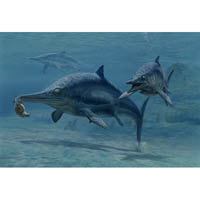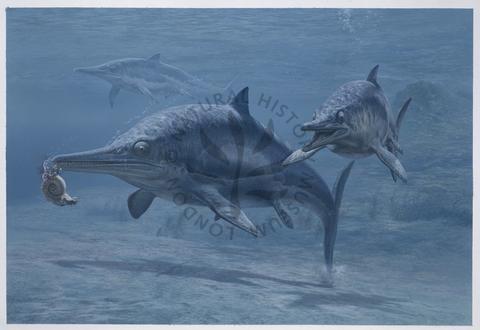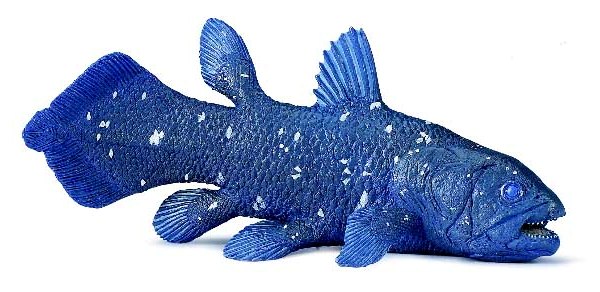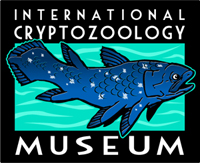Ichthyosaurus 2010
Posted by: Loren Coleman on September 16th, 2009
Another future museum replica to ponder? More breaking news?
So, the new rumored Safari Ltd’s 2010 Carnegie Ichthyosaurus is said to have a “closed jaw” and reportedly an “ammonite’s tentacles are in the mouth [of the Ichthyosaurus] not the [ammonite’s] shell. The shell is hanging off to the side of the [Ichthyosaurus’] jaws.”
I wonder if the new Carnegie replica is based on the artwork of Ichthyosaurus grendelius by John Sibbick.
Here is the sample painting he shows to sell this artwork.

His art is for sale on the Natural History Museum picture library site, and on that of Sibbick’s personal site.

Makes you wonder. Could the 2010 WS prehistoric marine life toob’s small Ichthyosaurus ~ which has its mouth open ~ be used in a diorama to represent a young Ichthyosaurus, as shown in the Sibbick painting above?

The 2010 Wild Safari Prehistoric Sea Life toob.
Sea Monsters were and are real. Heaven help the ammonites.
The oceans remain a dangerous place.

Wild Safari’s 2010 hotly anticipated coelacanth replica!
Lionfish, tiger sharks, Ichthyosaurus, giant squids, and coelacanths? Coming soon to a neighborhood museum shop near you.

Support the new, public, physical land-based but sea port location of the International Cryptozoology Museum in downtown Portland, Maine. Help us swim together towards this great adventure.
Come visit. Shop in the gift store. Donate to assist our survival.
Please click on the button below (not the one up top) to take you to PayPal to send in your museum donation.
If you wish to send in your donation via the mails, by way of an international money order or, for the USA, via a check or money order, please use this snail mail address:
Loren Coleman
International Cryptozoology Museum
PO Box 360
Portland, ME 04112
Thank you, and come visit the world’s first fully staffed public cryptozoology museum at 661 Congress Street, Portland, Maine 04101, beginning November 1, 2009!!
About Loren Coleman
Loren Coleman is one of the world’s leading cryptozoologists, some say “the” leading living cryptozoologist. Certainly, he is acknowledged as the current living American researcher and writer who has most popularized cryptozoology in the late 20th and early 21st centuries.
Starting his fieldwork and investigations in 1960, after traveling and trekking extensively in pursuit of cryptozoological mysteries, Coleman began writing to share his experiences in 1969. An honorary member of Ivan T. Sanderson’s Society for the Investigation of the Unexplained in the 1970s, Coleman has been bestowed with similar honorary memberships of the North Idaho College Cryptozoology Club in 1983, and in subsequent years, that of the British Columbia Scientific Cryptozoology Club, CryptoSafari International, and other international organizations. He was also a Life Member and Benefactor of the International Society of Cryptozoology (now-defunct).
Loren Coleman’s daily blog, as a member of the Cryptomundo Team, served as an ongoing avenue of communication for the ever-growing body of cryptozoo news from 2005 through 2013. He returned as an infrequent contributor beginning Halloween week of 2015.
Coleman is the founder in 2003, and current director of the International Cryptozoology Museum in Portland, Maine.










Sounds like another neat collectible. I’m looking forward to getting me one of those Prehistoric Sea Life Toobs. Those figures in the pic seem to be of much better quality than the previous Toob toys.
Looks like a Swordfish after being hit with Gamma Rays.
Truly Majestic. Truly Awe-Inspiring. Truly Pee-In-Pants Scary.
This is one of those “Dinosaurs” I wish was NOT around still. 🙁
This is the very first time I see a model of Basilosaurus. I sculpted one some months ago, and it is about 20 cm in length. But it is much longer and of different proportions than the little model shown on the picture with the collection. I once made a very small Basilosaurus model of about 5 cm or so, which looks similar to the one here. I used the BBC Basilosaurus as reference, but later after some research it turned out, that it was not very accurate (as several other BBC-creatures too). It could possibly resemble a shorter form like Prozeuglodon, but never Basilosaurus itself. One problem with a Basilosaurus sculpture is, that even if you make if comparably big, the head is still very small compared to the rest of the body.
The most interesting feature to me in this new painting, is the ‘chameleon-like’ eyes the artist decided to give to the ichthyosaurus. Don’t know if that would make much sense in a dark underwater environment, though.
The “chameleon-look” is actually not new, the picture is already comparably old, and ichthyosaurs are often portrayed in this way since the earliest times of paleontology. Ichthyosaurs had, as some living and extinct reptiles and birds, bony plates around their eyes, which were probably used for the focussing of the eye. This was especially important for ichthyosaurs, as their eyesight was their main sense in the water. You can see the bony plates here.
Ichthyosaurs actually not only evolved the largest eyes among all vertebrates, but even the largest eyes ever. The eyes of some giant forms were even larger than those of giant and colossal squid.